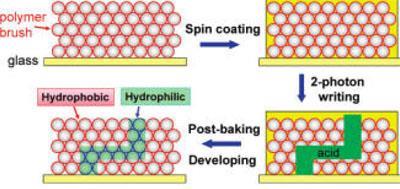Researchers have used a laser to write a hydrophilic pathway into a 3D hydrophobic matrix
US scientists have used a laser to write a hydrophilic pathway into a three-dimensional hydrophobic porous matrix. The technique has potential uses for selective transportation of aqueous and oily phases in 3D microfluidic systems, with the hydrophilic pathway able to be filled with water, while the remainder of the porous matrix is filled with oil.
The research, carried out by Paul Braun’s team at the University of Illinois at Urbana-Champaign, makes use of a known route to switch hydrophilicity in polymers using a two-photon laser.
The team’s porous matrix consists of colloidal silica crystals, functionalised - or ’brushed’ - with chains of poly(tetrahydropyranylmethacrylate). The gaps in this matrix are filled with a copolymer coating containing a photoacid initiator. When the two-photon laser directed into the matrix, the initiator absorbs the photons and acid is generated around the laser’s focal point. The focal point can then be moved through the 3D matrix, ’writing’ a pathway of acid through it. The matrix is the baked at 65?C to drive the acid-catalysed hydrolysis of the polymer’s hydrophobic ester groups into hydrophilic carboxylic acids. Finally, the team wash the matrix to remove the remainder of the coating - leaving behind the hydrophobic porous host with an embedded hydrophilic channel.

The team were able to demonstrate that oily hydrocarbon dodecane selectively enters the hydrophobic area of the matrix via capillary action, whereas water enters and flows through the hydrophilic channels. ’Our system is bi-phasic, meaning regions can be selectively filled with oily or aqueous phases,’ explains team member Matthew George.

’Patterning of hydrophilicity has generally been restricted to two-dimensions and hence the formation of 3D channels would require multiple 2D patterned layers to be post-assembled,’ says George. However, 3D patterning of this type has been seen in solid - that is, non-porous - structures before, with the hydrophilic patterned region washed away to leave a hollow channel. ’These systems cannot maintain two distinct phases (oil and water) as our system can,’ George explains.
Wilhelm Huck, an expert in polymer brushes from the University of Cambridge in the UK, describes this work as very nice: ’The limited thickness of surface-initiated brushes precludes 3D-type structure formation. Here, the authors have very cleverly exploited colloidal crystals as a scaffold for switchable polymer brushes, circumventing that limitation,’ he says.
Microfluidic devices are increasingly popular for manipulating fluids on the microscale, for uses ranging from analysis to carrying out tiny-scale synthetic reactions. As well as selective transport of aqueous and oily phases, this system could be used for mixing various input streams, says George. ’In the future we might also pursue a new system capable of photo-reversible 3D switching of regions between hydrophillic and hydrophobic states,’ he adds.
Nina Notman
References
et alJ. Am. Chem. Soc., 2009, DOI: 10.1021/ja904554m






No comments yet